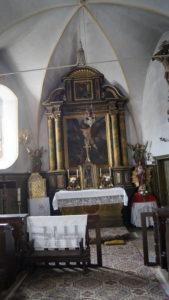See introduction to Mass Tourism series here for the motivation behind these essays.
Sunday morning (Nov 13), I left to attend St. Sebastian which posted a Latin Mass time of 10 AM. This tiny chapel in the middle of town at a sharp turn on the historic Ludwigstraße was built in 17th century and is the oldest church in Garmisch, if not the oldest building there altogether. All psyched up to attend Mass in a foreign country with no ability to “low-profile”, I arrived at the door which was locked shut. Peering through the dark windows, it seemed no one was there. A note tacked to the door revealed the situation, albeit in German. I was sure it stated that the Mass was postponed to 6PM. Nevertheless, I waited until the prescribed hour before returning to the apartment.
I decided to stop by the Netto market for bread but, wouldn’t you know, it was closed Sunday as were most businesses. Once upon a time it was true in America (and still in some towns)—that Sunday was a holy day of rest and one managed to reckon that fact into the week.
[Aside: Imbued by the culture, I have come to expect that stores will be open 24/7 for my convenience. I am convicted of the idea that we should return to a Closed-Sunday culture if not for religious purposes, but simply for the health and sanity of American society warped on money-making. Once attending a travel soccer game far away in Charlottesville, another father who I usually sat with was mocking the idea that local stores would be closed on Sunday for religious purposes (e.g. Chic-Fil-A). I just smirked in response but what I really wanted to say was, “You jerk! Do you think other families would like to spend time together at least one day of the week like you do? Is it so important that you get your hamburger value meal and a venti coffee at any hour of your life that others must scratch out a meager living to accommodate your every wish?” But I relented since I don’t exactly boycott businesses on Sunday myself.]
I returned to the chapel at the re-appointed time when all was dark and the streets were mostly empty. This time the chapel was open and some people had shown up. As I entered through the old wooden door, I immediately remember what Sigrid had told me, that there would be a group of people saying the rosary. I listened intently to determine what prayer was being uttered in German. The Fatima prayer almost sounded like the English version.
The chapel is very small, about 8 rows of pew split with a center aisle, each side wide enough to seat 3-4 people. There was absolutely nothing ergonomic about the sitting, the old pews possibly designed for function alone and no comfort—perhaps even mortification. I was forced to sit completely erect as the back rest shot a straight vertical with a seat slightly better than a 2×4 plank. Kneeling was no better, the kneeler raised so high, my feet could not touch the ground and my upper body ready to topple over the pew in front of me.
At the head of the church, the tabernacle was positioned tightly to the left side of the altar as if space would only allow that location. Above the altar was an old darkened painting of St. Sebastian, characteristically riddled with arrows and a doleful look heavenward.
Two priests entered through a side door, the celebrant being a man very young—around thirty—not something I imagine when I think of a Catholic priest. It was not just in my head that he fixed a prolonged stare on me–the oddity in this small chapel of senior women. Who let the American riff-raff in?
Ah but I had prepared my missal for this moment, reckoning that it was the 26th Sunday of Pentecost and my kindle at the ready with highlights. Mass started with Asperges, the traditional rite of sprinkling holy water on the congregation while the same traditional introit hymn is sung. The pews had been provisioned with a gray book Gotteslob which I saw in every church in Germany—an all-purpose book for the new liturgy and hymns. This chapel, however, had an additional small green booklet that was the hymns and responses for the High Latin Mass. For the most part, the Mass followed the words in my electronic Missal for the appointed day. Those parts where I was versed in the response, e.g. “Domine, non sum dignus ut intres sub tectum meum…” I made sure I was clearly heard so that everyone could be at ease that I just did not stumble into their singular worship service after touring Ludwigstraße purchasing bratwurst and souvenirs. American Riff-raff my foot!
Communion was kneeling at a 4-person altar rail which took all of 2 minutes. In this form of the Mass the communicant does not say Amen or anything—just quietly take the consecrated bread by mouth. I received the Eucharist in my mouth which I wasn’t nervous about. I think kneeling to take communion at an altar rail provides a certain level of security.
I meandered out of the Chapel after the final hymn. Waiting outside was the man sitting behind me. He was a distance from the door as if waiting for his spouse to pop out so that they could go home–typical. He looked at my brightly, “Guten Nacht.” I smiled and responded the same in my feeble German as I turned to go back to the apartment in the opposite direction.


